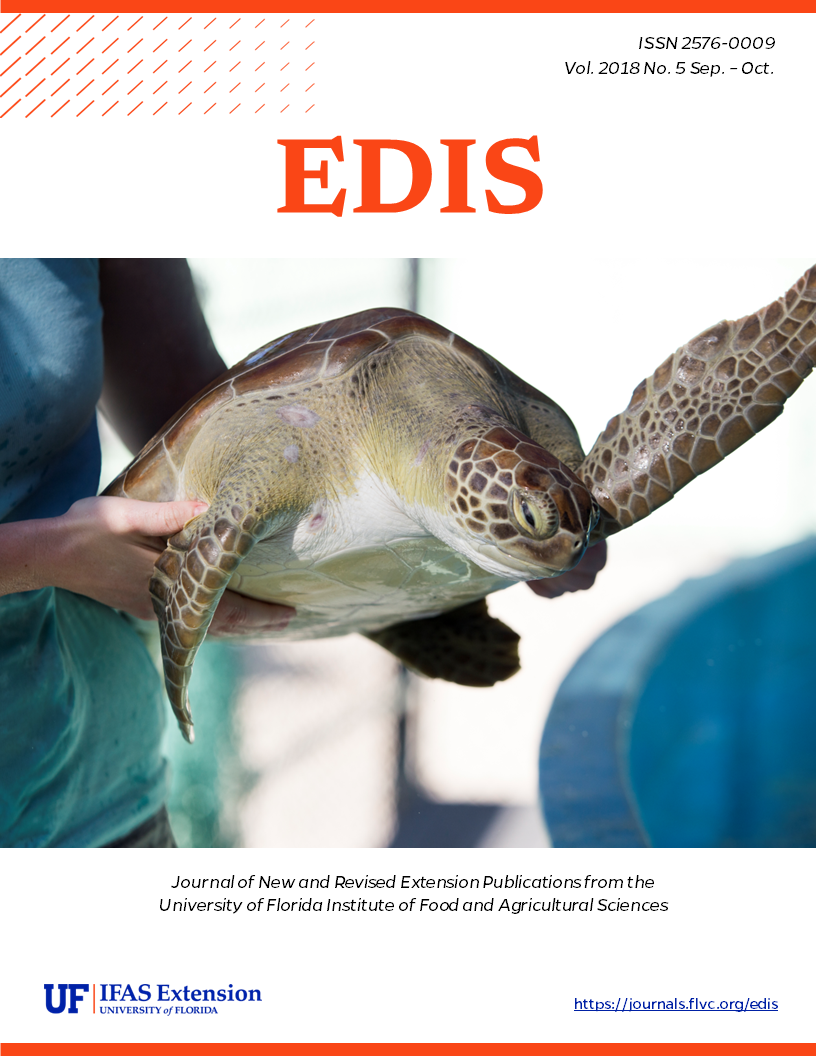Abstract
Many people are seeking available and effective options that are safer for people and the environment than some conventional synthetic pesticides. There is also rising interest in organic gardening, which relies on many natural pesticides. Natural products can be used in isolation or combination with conventional pesticide programs as valuable rotation options, delaying or preventing onset of insect and disease resistance caused by repeatedly using the same chemical controls. This publication describes natural products used in residential landscapes and gardens that are generally less toxic to non-target organisms and the environment, and when used correctly, can be effective tools for plant protection. These products are most effective when used in an integrated pest management (IPM) program along with sanitation, proper cultural or maintenance practices, mechanical control tactics, use of resistant plant varieties, and biological control, when possible.
References
Antonious, G. F., J. E. Meyer, J. A. Rogers, and Y. Hu. 2007. "Growing hot pepper for cabbage looper, Trichopulsia ni (Hübner) and spider mite, Tetranychus urticae (Koch) control." Journal of Environmental Science and Health Part B 42: 559-567. https://doi.org/10.1080/03601230701389512
Antonious, G. F., J. E. Meyer, and J. C. Snyder. 2006. "Toxicity and repellency of hot pepper extracts to spider mite, Tetranychus urticae Koch." Journal of Environmental Science and Health Part B 41(8): 1383-1391. doi: 10.1080/0360123060096419. https://doi.org/10.1080/0360123060096419
Arizona Cooperative Extension. 2006. "Diatomaceous earth… A reduced-risk pesticide." Pest Press, Issue 6, September 2006. https://cals.arizona.edu/urbanipm/pest_press/2006/september.pdf
Arthurs, S. P., L. F. Aristizábal, and P. B. Avery. 2013. "Evaluation of entomopathogenic fungi against chilli thrips, Scirtothrips dorsalis." Journal of Insect Science 13(31): 1-16. https://doi.org/10.1673/031.013.3101
Baldwin, R. 2008. "Soaps as insecticides." In Encyclopedia of Entomology, edited by J. L. Capinera. 3432-3440. Heidelberg, Germany: Springer Science+Business Media B.V.
Beckerman, J. 2008. "Using organic fungicides." BP-69-W. Purdue University: Purdue Extension. https://www.extension.purdue.edu/extmedia/BP/BP-69-W.pdf
Bográn, C. E., S. Ludwig, and B. Metz. 2006. "Using oils as pesticides." E-419. Texas A&M System: AgriLife Extension. http://oaktrust.library.tamu.edu/bitstream/handle/1969.1/86885/pdf_1192.pdf
Bunch, T. R., C. Bond, K. Buhl, and D. Stone. 2013. "Diatomaceous earth general fact sheet." National Pesticide Information Center, Oregon State University Extension Services. http://npic.orst.edu/factsheets/degen.html
Caldwell, B., E. Sideman, A. Seaman, A. Shelton, and C. Smart. 2013. Resource Guide for Organic Insect and Disease Management, 2 edition. Geneva, New York: Cornell University, New York State Agricultural Experiment Station. http://web.pppmb.cals.cornell.edu/resourceguide/pdf/resource-guide-for-organic-insect-and-disease-management.pdf
Capinera, J. L. 2018. "Assessment of barrier materials to protect plants from Florida leatherleaf slug (Mollusca: Gastropoda: Veronicellidae)." Florida Entomologist 101(3). https://doi.org/10.1653/024.101.0327
Chalker-Scott, L. 2009. "Baking soda: Will fungi fail and roses rejoice?" MasterGardener (Spring 2009): 2-4. https://s3.wp.wsu.edu/uploads/sites/403/2015/03/baking-soda.pdf
Cloyd, R. A. 2015. "Explaining azadirachtin and neem." GNP Magazine (November 2015): 10. http://gpnmag.com/wp-content/uploads/GPNNov_Dr.Bugs_.pdf
Cordova-Kreylos, A. L., L. E. Fernandez, M. Koivunen, A. Yang, L. Flor-Weiler, and P. G. Marrone. 2013. "Isolation and characterization of Burkholderia rinojensis sp. nov., a non-Bcc soil bacterium with insecticidal and miticidal activity." Applied and Environmental Microbiology 79(24): 7669-7678. https://doi.org/10.1128/AEM.02365-13
Cranshaw, W. S. 2008. "Insect control: Soaps and detergents." Fact Sheet No. 5.547. Colorado State University Extension. http://extension.colostate.edu/docs/pubs/insect/05547.pdf
Gaskin, J. W., P. Hartel, E. Little, and G. Harris. 2013. "Soil inoculants." Circular 990. University of Georgia College of Agricultural and Environmental Sciences Cooperative Extension. https://secure.caes.uga.edu/extension/publications/files/pdf/C%20990_2.PDF
Grasswitz, T. R. 2012. "Selection and use of insecticides for organic production." Guide H-168. New Mexico State University, College of Agricultural, Consumer, and Environmental Sciences. http://aces.nmsu.edu/pubs/_h/H168.pdf
Grewal, P. and R. Georgis. 1999. "Chapter 15: Entomopathogenic nematodes." In Biopesticides: Use and Delivery (Methods in Biotechnology: 5), edited by F. R. Hall and J. J. Menn. Totowa, NJ: Humana Press Inc.
IR-4. 2017. "Ornamental Horticulture Program Research Project, borer and foliar-feeding beetle efficacy." USDA-NIFA Minor Crop Pest Management Program Interregional Research Project #4. Accessed on September 14, 2018. https://www.ir4project.org/ehc/ehc-registration-support-research/env-hort-extension-resources/
Johnson, D. L. 1989. "The effects of timing and frequency of application of Nosema locustae (Microspora: Microsporida) on the infection rate and activity of grasshoppers (Orthoptera: Acrididae)." Journal of Invertebrate Pathology 54: 353-364. https://doi.org/10.1016/0022-2011(89)90119-5
Maia, M. F. and S. J. Moore. 2011. "Plant-based insect repellents: a review of their efficacy, development and testing." Malaria Journal 10(Suppl 1): S11. http://doi.org/10.1186/1475-2875-10-S1-S11 https://doi.org/10.1186/1475-2875-10-S1-S11
Moreau, T. L., P. R. Warman, and J. Hoyle. 2006. "An evaluation of companion planting and botanical extracts as alternative pest controls for the Colorado potato beetle." Biological Agriculture and Horticulture 23: 351-370. https://doi.org/10.1080/01448765.2006.9755336
National Pesticide Information Center. 2001. "Potassium salts of fatty acids (Technical fact sheet)." NPIC. http://npic.orst.edu/factsheets/archive/psfatech.pdf
Onsager, J. A. 1988. "Assessing effectiveness of Nosema locustae for grasshopper control." Montana Agricultural Experiment Station Bulletin 5: 12-16.
Pedigo, L. P. 1999. Entomology and Pest Management, 3 edition. Upper Saddle River, NJ: Prentice Hall.
Peter, K. 2016. "Demystifying copper for disease management." Penn State University, College of Agricultural Sciences. https://agresearch.umd.edu/sites/agresearch.umd.edu/files/_docs/locations/wye/2016%20Winter%20meeting_Copper.pdf
Pundt, L. 2015. "Insecticidal soaps." University of Connecticut Integrated Pest Management Program. http://ipm.uconn.edu/documents/raw2/800/2015insecticidalsoapfactsheet.pdf
Schmutterer, H. 1990. "Properties and potential of natural pesticides from the neem tree, Azadirachta indica." Annual Review of Entomology 35: 271-97. https://doi.org/10.1146/annurev.en.35.010190.001415
Scott, I. M., H. Jensen, J. G. Scott, M. B. Isman, J. T. Arnason, and B. J. R. Philogène. 2003. "Botanical insecticides for controlling agricultural pests: Piperamides and the Colorado potato beetle Leptinotarsa decemlineata say (Coleoptera: Chrysomelidae)." Archives of Insect Biochemistry and Physiology 54: 212-225. https://doi.org/10.1002/arch.10118
Stark, J. D. and J. F. Walter. 1995. "Neem oil and neem oil components affect the efficacy of commercial neem insecticides." Journal of Agricultural and Food Chemistry 43: 507-512. https://pubs.acs.org/doi/pdf/10.1021/jf00050a047 https://doi.org/10.1021/jf00050a047
Ware, G. W. and D. M. Whitacre. 2000. The Pesticide Book, 6 edition. Willoughby, OH: MeisterPro Information Resources.
Unless otherwise specified, articles published in the EDIS journal after January 1, 2024 are licensed under a Creative Commons Attribution-NonCommercial-NoDerivs 4.0 International (CC BY-NC-ND 4.0) license.

